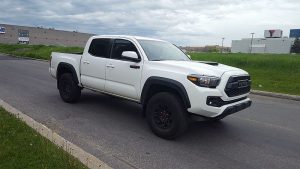All Wheel Drive

At once, if you wanted a vehicle with 4 driven wheels, you were restricted to simply a handful of large trucks and full-size SUVs, a lot of which were made use of for work tasks or off-road journey.
However times have changed. Now 45 percent of brand-new automobiles sold in the U.S. are furnished with either four-wheel drive (AWD) or 4×4 (4WD), according to an Edmunds analysis of IHS Market data. For cars that have AWD or 4WD as an option, 61 percent of buyers pick a design with either. In states with chilly or snowy winter seasons, this increases to 90 percent or greater.
So the popularity of automobiles that can send out power to both the front and also back wheels is growing. But what’s the distinction between AWD as well as 4WD? As well as which is ideal for you? AWD vs. 4WD terms can sometimes be confusing, particularly given that AWD systems have actually ended up being extra durable as well as 4WD has gotten a lot more innovative, obscuring the distinction between both. Including in the complication, numerous auto-producers frequently make use of these terms differently.
Right here’s how each system functions and the benefits as well as disadvantages of each. With this knowledge, you can make a notified decision when buying your following family SUV, midsize SUV, cars and truck or vehicle.
What Is All-Wheel Drive?
As the name indicates, all-wheel-drive systems power both the front and also back wheels regularly. However in method, there are in fact 2 sorts of drivetrains that are called AWD. One does, actually, drive all the wheels constantly, and also some manufacturers describe this as permanent AWD. The second, usually called part-time AWD or automated AWD, operates the majority of the moment in two-wheel-drive setting, with power provided to all four edges only when additional grip control is required.
How Does Four-wheel Drive Function?
AWD systems, both permanent as well as part-time, typically run without any input from the driver, although some offer selectable settings that enable a degree of control over just how much power goes where. All the wheels obtain torque through a collection of differentials, thick combinings and/or multiplate clutches, which assist disperse power to the wheels to make sure that the vehicle’s traction is enhanced. The vehicle still runs efficiently under normal conditions.
Full time AWD.
In full-time AWD, both the front and back axles are driven at all times. On completely dry pavement, this sort of AWD can help the lorry take care of much better and also make certain that complete power reaches the roadway. As well as in slippery problems, such as ice, snow or mud, it supplies additional traction for safer, a lot more confident handling.
Part-Time AWD.
In typical procedure, part-time AWD sends torque to two driven wheels, either the front or rear, depending on the make and also design. The system after that instantly involves the other two wheels when road conditions demand extra grip. Modern part-time AWD utilizes a range of electronic sensors that feed info to a computer, which regulates the amount of power directed per wheel.
All-Wheel-Drive Advantages And Disadvantages
The best aspect of AWD is that the motorist doesn’t have to make any decisions about engaging the system. Either all the wheels are being driven full-time, or the system itself is created to notice loss of grip and send power where it’s needed. AWD is offered on a variety of vehicles, from small sedans to performance models to all sizes of SUVs, offering you a broad variety of options.
While AWD has the ability to work well in a range of problems, from rain to snow to light off-roading, it’s normally taken into consideration a lower selection by significant off-roaders. This assumption is changing somewhat as contemporary AWD systems improve and also extra qualified, yet numerous chauffeurs who such as to venture away the beaten course still favor to make a decision on their own when to engage 4×4. AWD likewise boosts the price of a lorry as well as, in most cases, will certainly lower fuel economy.
AWD vs. 4WD in Snow
A number of points to remember up front: Whether you choose AWD or 4WD, any type of automobile can lose traction and spin out if pushed hard sufficient. And while both systems are developed to raise grip by engaging the front and back wheels, neither helps you stop much better. Having claimed that, both AWD and also 4WD can offer you a significant benefit in snowy and icy conditions as well as may be worth the extra expense, depending on where you live and also how you utilize your vehicle.
Driving in winter often suggests experiencing a selection of quickly altering roadway surfaces, from soft snow to hard-packed snow to glare ice. AWD systems, which supply power to all 4 wheels all the time, or immediately involve four-wheel torque when needed, are best at taking care of these transforming problems. They take the guesswork out of the formula and also can act more quickly than a chauffeur to take care of variable road surface areas.
On the other hand, 4WD is typically appropriate to browsing deeper snow or other much more extreme winter months problems. It can obtain you unstuck from a snowdrift extra conveniently, manage icy hills more effectively, and also obtain you to function safely before the roads are raked.
Do You Need AWD or 4WD?
Unsurprisingly, the answer to the AWD vs. 4WD discussion is that it relies on where you live and what type of driving problems you encounter, along with personal taste.
AWD can be located in autos, trucks as well as SUVs of all sizes, from portable to full-size, offering you the widest feasible variety of lorries to pick from. It delivers boosted grip under typical winter months problems or light off-roading and also offers the least concessions in flight and also fuel economic climate on completely dry roadways. As well as it has the benefit of either powering all four wheels on a constant basis or automatically regulating which corner obtains the torque, taking the decision-making process out of the vehicle driver’s hands.
4WD might be the better option for those that stay in remote areas, require to operate in severe weather conditions, or take pleasure in off-road adventuring. This system frequently is available in vehicles and SUVs with greater ground clearance than typical, making them fit to handling deep snow, rocky surface as well as steep qualities, as well as bring or lugging heavy tons. On top of that, the designs with part-time 4WD and low- and high-range functions give the driver the greatest amount of control over where and also just how the power is delivered.
